The Electric Soap Dispenser Market is estimated to be valued at USD 1.5 billion in 2025 and is projected to reach USD 2.8 billion by 2035, registering a compound annual growth rate (CAGR) of 6.3% over the forecast period.
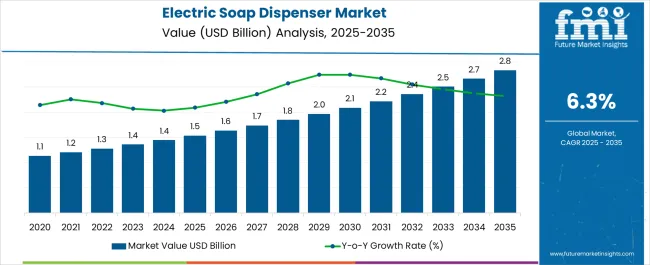
| Metric | Value |
|---|---|
| Electric Soap Dispenser Market Estimated Value in (2025 E) | USD 1.5 billion |
| Electric Soap Dispenser Market Forecast Value in (2035 F) | USD 2.8 billion |
| Forecast CAGR (2025 to 2035) | 6.3% |
The electric soap dispenser market is experiencing steady expansion as hygiene awareness and automation trends continue to reshape both commercial and residential sanitation practices. Rising demand for touchless solutions in healthcare, hospitality, and public spaces has accelerated the adoption of sensor-based dispensers. The market is also benefiting from increased integration of smart features such as infrared detection, adjustable dispensing volumes, and rechargeable battery systems.
Regulatory guidelines emphasizing hand hygiene in high-risk environments and the influence of wellness-conscious consumer behavior are further fueling demand. Manufacturers are investing in compact, ergonomic designs and sustainable materials to cater to diverse end-user needs while enhancing aesthetic appeal.
The shift toward e-commerce and digital retail platforms is making these products more accessible across regions, while partnerships with facility service providers are expanding commercial-scale installations. Long-term growth is expected to be supported by the convergence of design innovation, antimicrobial surface technologies, and sustainability-driven procurement.
The market is segmented by Material Type, End User, and Distribution Channel and region. By Material Type, the market is divided into Plastic, Stainless Steel, Chrome, Bronze, and Others. In terms of End User, the market is classified into Healthcare, Hospitality, Schools, Household, and Others. Based on Distribution Channel, the market is segmented into Online Store, Retail Stores, Hypermarket/Supermarket, Specialty Stores, Convenience Stores, Official Websites, and 3rd Party Websites. Regionally, the market is classified into North America, Latin America, Western Europe, Eastern Europe, Balkan & Baltic Countries, Russia & Belarus, Central Asia, East Asia, South Asia & Pacific, and the Middle East & Africa.
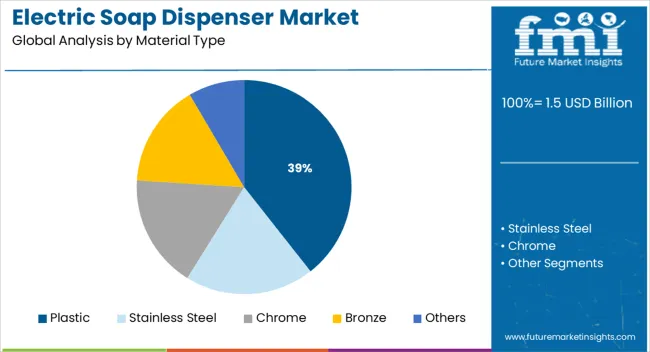
Plastic-based electric soap dispensers are anticipated to hold 39.4% of the total revenue share in 2025, making them the leading material type segment. This leadership is being driven by the lightweight nature, design flexibility, and cost-effectiveness of plastic components.
Plastic offers manufacturers the ability to produce dispensers in a wide range of shapes and sizes, catering to both compact household units and large-capacity commercial models. Advancements in injection molding and the growing availability of recyclable or bio-based plastics have supported increased sustainability alignment.
The material's chemical resistance and compatibility with diverse soap formulations also enhance product durability. Additionally, ease of customization through coloring, branding, and transparent casing options makes plastic dispensers favorable for brand visibility in both retail and institutional settings.
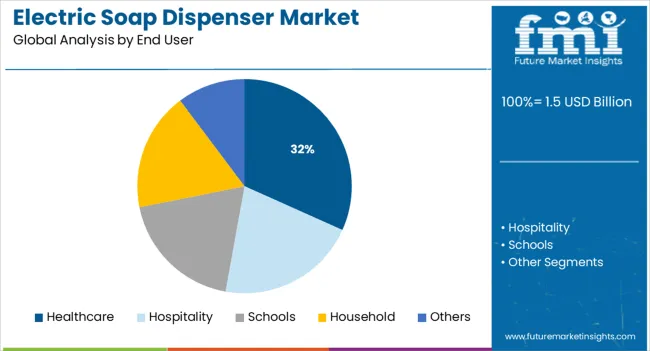
The healthcare segment is projected to account for 31.7% of the overall market revenue in 2025, ranking it as the dominant end user category. This segment’s growth is being fueled by stringent infection control protocols and increased emphasis on touch-free operations in clinical environments.
Electric dispensers offer consistent, contactless delivery that reduces contamination risks in hospitals, clinics, and diagnostic labs. Their integration with automated hand hygiene monitoring systems enhances compliance and operational efficiency.
Government healthcare spending and investments in public health infrastructure have led to expanded adoption across primary and tertiary care centers. As hygiene standards evolve globally, healthcare facilities are expected to remain the most consistent and regulation-driven adopters of sensor-based dispensing technology.
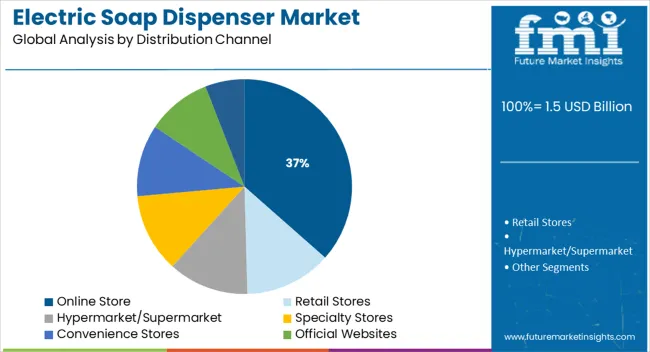
Online retail platforms are expected to contribute 36.5% of total market revenue by 2025, establishing them as the leading distribution channel for electric soap dispensers. This prominence is being shaped by the convenience, product variety, and price transparency offered by e-commerce channels.
Direct-to-consumer brands, third-party marketplaces, and dedicated sanitaryware portals have all contributed to broader market penetration, especially in Tier II and III cities. Product demonstrations, customer reviews, and digital advertising have increased buyer confidence and awareness, accelerating adoption in both home and small-business segments.
Subscription-based refill programs and bundled hygiene kits are also gaining traction through online platforms. The shift toward contactless purchasing post-pandemic has further entrenched digital storefronts as a primary channel for hygiene and automation-related products.
Online market sites like Amazon and Flipkart are the biggest markets for these dispensers. There is a number of different type of electric soap dispensers, from different costs to designs and colors, and people are getting freedom of choice to select a suitable dispenser. People are also purchasing these dispensers as they are modern and using automated machinery is trending. Increasing disposable income is also helping the increasing sales of electric soap dispensers.
The electric dispensers are fitted with sensors and valves, which help in the accurate dispensing of soap. There are adjustment buttons, which quickly adjust the soap amount, without any mess and complications. Such convenience without touching the dispenser is attracting people from all around the world to these electric dispensers, boosting the market value.
The soap dispensers are used for their efficiency and accuracy. The main market for dispensers is in different sectors like hospitality, food, and healthcare. However, there are limited sales in households, as mainly manual dispensers and bar soaps are commonly preferred by families.
There are other options that help in effective hand disinfection, other than soaps. Hand sanitizers and rubbing alcohols disinfect without using water or other requirements. These easy methods along with other cheaper options are being restrained by market growth.
The electric dispensers are costly, due to the different components used in them. Infrared sensors, motors, and valves along with the specially designed body are making these dispensers expensive. Most people with high disposable income are purchasing these electric dispensers, while middle-class people are preferring manual dispensers, due to the price difference. These are some market restraints hindering market growth.
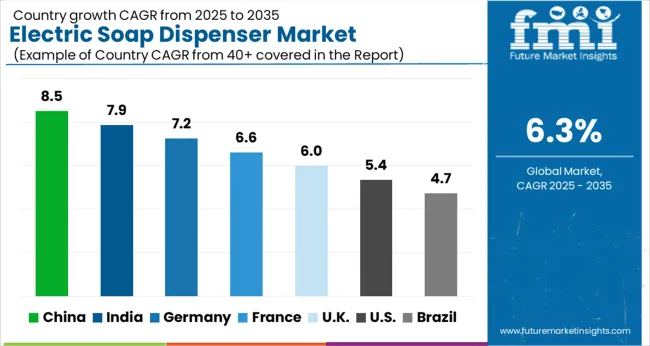
The United States is observing a surge in the use of electric soap dispensers. There are electric soap dispensers in different industries, including food facilities, hospitals, schools, and many others. The increasing trend of smart restrooms is also helping in increasing the use of these dispensers. The safety concerns of people in public places are now over, as many facilities are using electric soap dispensers.
China is the leading market for electric soap dispensers. There are manufacturers and consumers in the country, that are helping the dispenser market grow. People are getting more health conscious due to the recent pandemic.
Visiting public places and use of public services are now limited in the country, and touch-free dispensers are gaining popularity as they ensure the safety of users. The dispensers with indicators and optional modifications are popular due to their ease and convenience of use.
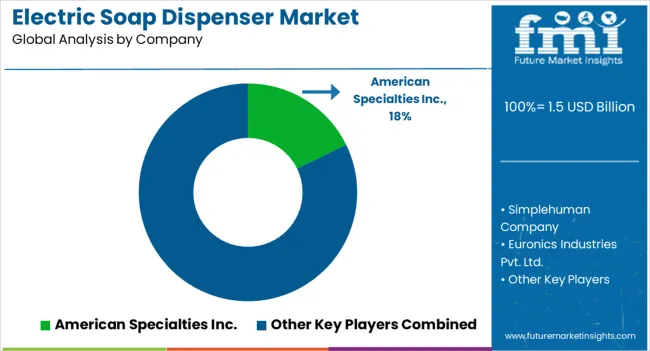
Some key players in the Electric Soap Dispenser market are American Specialties Inc., Simplehuman Company, Euronics Industries Pvt. Ltd., GOJO Industries Inc., BAFX Products Company, Philippe Taglioni Company, Nivahome Company, PerPik Company, Rubbermaid Commercial Products Company, Palmer Fixture Company, Umbra Company, and others.
| Attribute | Details |
|---|---|
| Growth Rate | CAGR of ~6.3% from 2025 to 2035 |
| Base year for estimation | 2024 |
| Historical Data Available for | 2020 to 2024 |
| Forecast Period | 2025 to 2035 |
| Quantitative units | Revenue in USD Billion, volume in Units, and CAGR from 2025 to 2035 |
| Report Coverage | Revenue forecast, volume forecast, company ranking, competitive landscape, growth factors, and trends, pricing analysis |
| Segments Covered | Material Type, End User, Distribution Channel, Region |
| Country scope | USA, Canada, Mexico, Germany, UK, France, Italy, Spain, Russia, India, Thailand, China, India, Japan, Australia, Brazil, Argentina, Colombia, Saudi Arabia, UAE, South Africa |
| Key Companies Profiled |
American Specialties Inc.; Simplehuman Company; Euronics Industries Pvt. Ltd.; GOJO Industries Inc.; BAFX Products Company; Philippe Taglioni Company; Nivahome Company; PerPik Company; Rubbermaid Commercial Products Company; Palmer Fixture Company; Umbra Company; Others |
| Customization scope | Free report customization (equivalent to up to 8 analysts' working days) with purchase. Addition or alteration to country, regional & segment scope. |
| Pricing and purchase options | Avail customized purchase options to meet your exact research needs. |
The global electric soap dispenser market is estimated to be valued at USD 1.5 billion in 2025.
The market size for the electric soap dispenser market is projected to reach USD 2.8 billion by 2035.
The electric soap dispenser market is expected to grow at a 6.3% CAGR between 2025 and 2035.
The key product types in electric soap dispenser market are plastic, stainless steel, chrome, bronze and others.
In terms of end user, healthcare segment to command 31.7% share in the electric soap dispenser market in 2025.






Our Research Products

The "Full Research Suite" delivers actionable market intel, deep dives on markets or technologies, so clients act faster, cut risk, and unlock growth.

The Leaderboard benchmarks and ranks top vendors, classifying them as Established Leaders, Leading Challengers, or Disruptors & Challengers.

Locates where complements amplify value and substitutes erode it, forecasting net impact by horizon

We deliver granular, decision-grade intel: market sizing, 5-year forecasts, pricing, adoption, usage, revenue, and operational KPIs—plus competitor tracking, regulation, and value chains—across 60 countries broadly.

Spot the shifts before they hit your P&L. We track inflection points, adoption curves, pricing moves, and ecosystem plays to show where demand is heading, why it is changing, and what to do next across high-growth markets and disruptive tech

Real-time reads of user behavior. We track shifting priorities, perceptions of today’s and next-gen services, and provider experience, then pace how fast tech moves from trial to adoption, blending buyer, consumer, and channel inputs with social signals (#WhySwitch, #UX).

Partner with our analyst team to build a custom report designed around your business priorities. From analysing market trends to assessing competitors or crafting bespoke datasets, we tailor insights to your needs.
Supplier Intelligence
Discovery & Profiling
Capacity & Footprint
Performance & Risk
Compliance & Governance
Commercial Readiness
Who Supplies Whom
Scorecards & Shortlists
Playbooks & Docs
Category Intelligence
Definition & Scope
Demand & Use Cases
Cost Drivers
Market Structure
Supply Chain Map
Trade & Policy
Operating Norms
Deliverables
Buyer Intelligence
Account Basics
Spend & Scope
Procurement Model
Vendor Requirements
Terms & Policies
Entry Strategy
Pain Points & Triggers
Outputs
Pricing Analysis
Benchmarks
Trends
Should-Cost
Indexation
Landed Cost
Commercial Terms
Deliverables
Brand Analysis
Positioning & Value Prop
Share & Presence
Customer Evidence
Go-to-Market
Digital & Reputation
Compliance & Trust
KPIs & Gaps
Outputs
Full Research Suite comprises of:
Market outlook & trends analysis
Interviews & case studies
Strategic recommendations
Vendor profiles & capabilities analysis
5-year forecasts
8 regions and 60+ country-level data splits
Market segment data splits
12 months of continuous data updates
DELIVERED AS:
PDF EXCEL ONLINE
Electric Aircraft Onboard Sensors Market Size and Share Forecast Outlook 2025 to 2035
Electrical Label Market Size and Share Forecast Outlook 2025 to 2035
Electric Round Sprinklers Market Size and Share Forecast Outlook 2025 to 2035
Electric Cloth Cutting Scissors Market Size and Share Forecast Outlook 2025 to 2035
Electrical Insulation Materials Market Size and Share Forecast Outlook 2025 to 2035
Electric Aircraft Sensors Market Size and Share Forecast Outlook 2025 to 2035
Electric Traction Motor Market Forecast Outlook 2025 to 2035
Electric Vehicle Sensor Market Forecast and Outlook 2025 to 2035
Electric Vehicle Motor Market Forecast and Outlook 2025 to 2035
Electric Off-Road ATVs & UTVs Market Size and Share Forecast Outlook 2025 to 2035
Electric Blind Rivet Gun Market Size and Share Forecast Outlook 2025 to 2035
Electric Fireplace Market Size and Share Forecast Outlook 2025 to 2035
Electric Glider Market Size and Share Forecast Outlook 2025 to 2035
Electric Vehicle Battery Conditioners Market Size and Share Forecast Outlook 2025 to 2035
Electric Power Steering Motors Market Size and Share Forecast Outlook 2025 to 2035
Electric Motor Market Size and Share Forecast Outlook 2025 to 2035
Electric Gripper Market Size and Share Forecast Outlook 2025 to 2035
Electric Boat Market Size and Share Forecast Outlook 2025 to 2035
Electric Bicycle Market Size and Share Forecast Outlook 2025 to 2035
Electric Vehicle Transmission Market Size and Share Forecast Outlook 2025 to 2035

Thank you!
You will receive an email from our Business Development Manager. Please be sure to check your SPAM/JUNK folder too.
Chat With
MaRIA